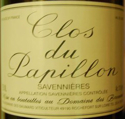|
Chenin Blanc Wine
Outside of the Loire, the grape is often used just as a blending grape for inexpensive wines. An exception is in South Africa where it is called Steen. Without a distinct terroir to give it character, the grape can seem rather neutral and bland. At its best, when the grape ripens in a terroir suited to it, Chenin Blanc is capable of making some of the best wines in the world, although it rarely gets the respect it deserves. The grape's high natural acidity means that it can make just about any style of wine, from sparkling wines to sticky sweet, and everything in between. The acid helps to keep everything in balance, even with a high level of residual sugar. Where Is Chenin Blanc Wine Made?Chenin Blanc wine reaches its greatest heights where it resides naturally, in the Loire Valley of France. It probably first arose in the Anjou, a region on the Loire River. Today, some of the best wines are still produced there. In particular, the dry wines of Savennières can be quite full, complex and can age a very long time. The sweet wines from surrounding areas, including the Coteaux du Layon and Quarts de Chaume can be outstanding.Further east on the Loire, the village of Vouvray makes the other best example of 100% Chenin Blanc wine. They range from dry (sec) to off-dry (demi-sec) to sweet (moelleux). Various other regions in the Loire produce Chenin Blanc based wines as well, notably Jasnières and Bonnezeaux. Of note, most Loire Chenin Blancs are named for the region they came from, such as Vouvray, not for the grape variety. So you will not find the name Chenin Blanc on the label of most. Also, in some parts of the Loire the grape is known as Pineau de la Loire. It is almost always vinified alone, 100% Chenin Blanc, unblended with other grapes. What Styles of Wine Does Chenin Blanc Produce and What Do They Taste Like?As mentioned above, Chenin Blanc is capable of producing a wide range of wine styles, practically any in fact. For one, the sparkling wines made from the grape variety in the Loire, particularly from Vouvray, can be outstanding. They tend to be a bit lighter in body than most Champagnes but with a fruity freshness. Their subtlety and finesse can be noteworthy, comparing favorably to the more famous Champagne. They tend to be a great, inexpensive value option for sparkling wine as even the best, such as the Vouvray Petillant produced by Domaine Huet, can be found for a fraction of the price of most Champagnes.Dry white table wines are also produced, notably in Savennières. The wines can be quite full-bodied with great depth. They tend to start out life quite wound up and intense, with high acid and a thrilling minerality that keeps them feeling lean and taut. As they age they open up and become more floral, waxy and honeyed with a round, luxurious texture. They can be quite long lived and are an excellent option for full-bodied, complex white wines considering that other great options, such as white Burgundy, can be much more expensive. Vouvray also produces dry examples, called sec. They tend to be slightly less full bodied than Savennieres and a bit fruitier, even with a hint of residual sugar, but with a similar intensity of acid and minerality. The best are remarkably food friendly. Chenin Blanc also makes off-dry wines, often termed demi-sec, particularly in Vouvray. These wines are similar to the sec wines but with a bit more residual sugar and fuller body. Finally, Chenin Blanc wine can also be made quite sweet and the best examples are some of the best sweet white wines in the world. Most of these are made from late-harvested grapes that are often affected by the "noble rot" botrytis cinerea, concentrating the grape sugars and flavors. There are several areas of the Anjou that produce such wines but the two most famous examples are Quarts de Chaume, a small grand cru vineyard, and Vouvray further east. The sweet wines of Vouvray are usually labeled moelleux. Both wines are generally produced from grapes affected by botrytis and can be very concentrated, very sweet and very long lived, aging practically indefinitely. Although they have their own character, these wines are along the lines of Sauternes, Trockenbeerenauselen and other sweet white wines produced from botrytis affected grapes. These are generally drank alone after dinner or with simple desserts, nuts or cheese. Return to the Grape Varieties section.  |



 The most famous and respected Chenin Blanc wine comes from various areas of the Loire Valley in France. The grape variety Chenin Blanc is widely planted but examples of wines from elsewhere are sparse, and rarely much good.
The most famous and respected Chenin Blanc wine comes from various areas of the Loire Valley in France. The grape variety Chenin Blanc is widely planted but examples of wines from elsewhere are sparse, and rarely much good.


